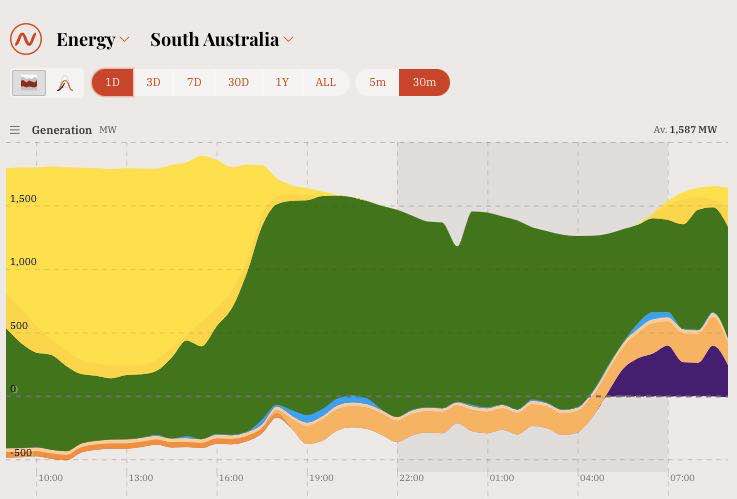| |
Australia's richest billionaire, Gina Rinehart, who has been notoriously opposed to renewable energy and has interests in the mining of millions of tonnes of coal annually, is based in WA.
Meg O'Neill, the CEO of Woodside Energy, one of the world's biggest oil and gas company's, lives in WA.
Does the go-slow-on-renewable-energy policy in the McGowan and Cook governments have anything to do with the influence of people and companies like these?
|
|
Premier McGowan has been big on talk about renewable energy and cutting emissions but slow on action.
We are told that the coal-fired power stations will be shut down, but they haven't been yet. There are plans for off-shore wind farms along the coast and huge renewable energy developments in the north, but if they happen at all it won't be for years.
Western Australia, Australia, and the world needs action on reducing emissions, not talk.
In case any readers don't know, 'gunnado' is Ausie slang for 'going to do'. A person might be nicknamed gunnado if they consistently say they are going to do things but never actually do much at all.
| |
One of SA's many wind farms
|
|---|

| | My old state, SA, is way ahead of WA.
| |
South Australia has had
great success in the adoption of renewable energy. Tasmania is nearly 100% renewables-powered, because of its hydropower that was built years ago. Victoria and NSW are making serious efforts to catch up. Even Queensland, the slow starter, now has big projects completed and more under way.
But SA has been the uncontested leader in new renewables and it continues to build wind farms: the most recently completed ones, at Port Augusta (317MW) and Lincoln Gap (212MW), both of which started operating in 2022 and both bigger than any wind farms in WA. In the twelve months up to the time of writing (May 2023), Open NEM recorded that WA's electricity supply was 35% renewable, while SA's was 69%. Both had very little renewable energy back in 2005.
In WWF's Renewable Superpower Scorecard #3, 2022, WA was ranked last among the Australian states.
WA has far more income from the mining sector than SA. You can see the difference in wealth between the two states in things like the quality of the roads.
But where SA has encouraged the development of renewable energy, to its credit and advantage, WA has adopted a 'go slow' attitude to renewables.
WA has wealth and huge renewable energy resources waiting to be tapped, but very little is actually happening in developing them. Surely WA is squandering a great opportunity.
WA has done quite well in solar photovoltaic power, but that is far more to do with the Western Australian people recognising that solar power just makes economic sense than it does with government action. In the 12 months to the time of writing WA had 16% of it power being generated from rooftops, and 2% from utility-scale solar farms. The corresponding figures for SA were 18% and 5% - it seems that the WA government has given far less incentive for commercial solar farm development than has the SA government.
WA's coal-fired power stations are going to be shut down (sometime, we are told). South Australia's last coal-fired power station was shut down in 2016.
There are huge renewable energy projects proposed (by private industry) in WA's north. That's great, but there's nothing on the ground yet.
There are big off-shore wind farms proposed for the southwest, again, by private industry, but if they happen at all it won't be until the late 2020s.
When will the next big renewable energy project be built in WA? It's anyone's guess, but it doesn't look like it will be happening anytime soon. When was the last one built? Quite a while ago it seems, and then it was not as big as recent projects in the other states.
Does WA have electric busses yet? No. Nor electric trams.
It has been suggested, jokingly no doubt, but perhaps appropriately, that WA stands just as much for 'wait awhile' as it does for Western Australia.
On 2023/05/26 I emailed the McGowan government (WA-Government@dpc.wa.gov.au) notifying them of my impressions and of this Web page. I had an automatic reply confirming that my email had been received. Nothing more came over the next several months.
The
episode over the out-of-proportion police reaction to an intended peaceful protest at the house of the CEO of Woodside Energy
Meg O'Neill showed how the Western Australian government looks after the fossil fuel industries at the expense of the future of the planet. Apparently all that matters to the WA government is protecting the moneyed interests.
The WA police are trying to force the ABC to reveal their sources of information. It is the right and responsibility of news media to protect the privacy of their sources. If people know that their personal details will be given to the police they will be much more reluctant to report wrong-doing and corruption.
The attitude that lies behind the Western Australian government's increasingly aggressive and punitive treatment of any environmental protest would be linked to their very slow actions on reducing emissions.
The ABC covered the incident in more detail on there own page.


